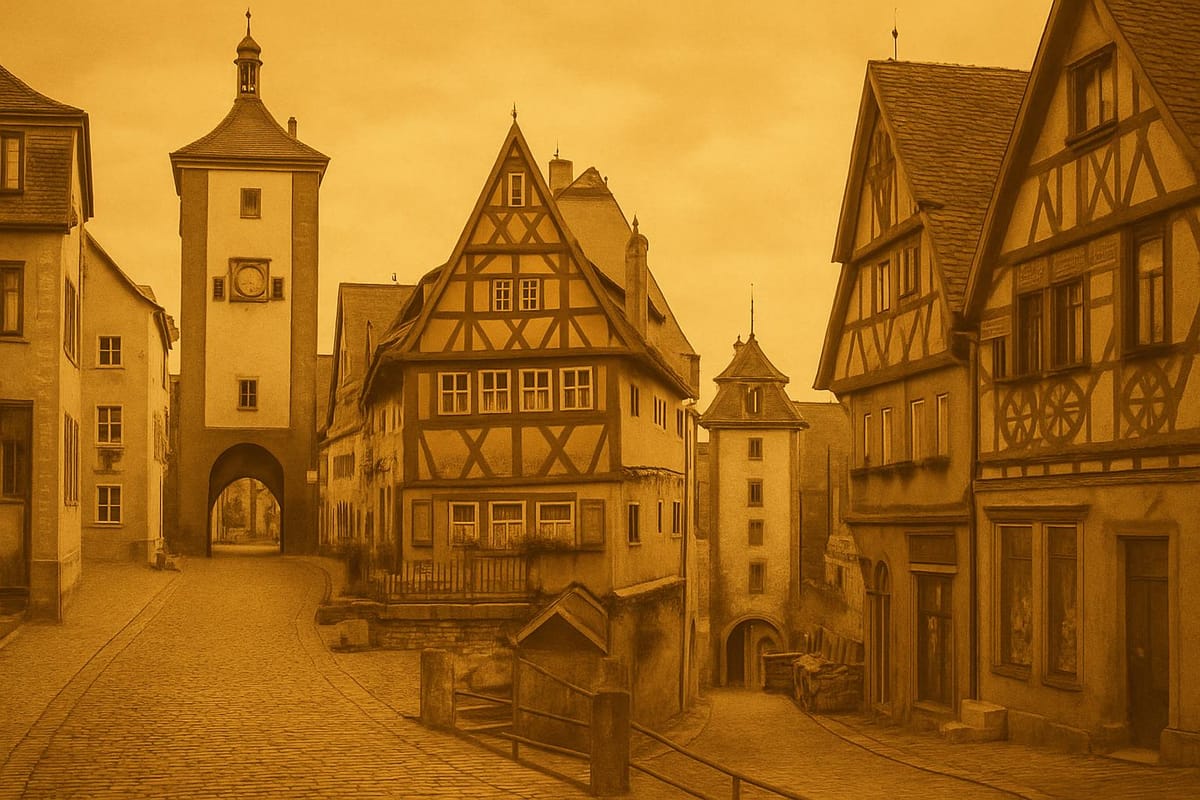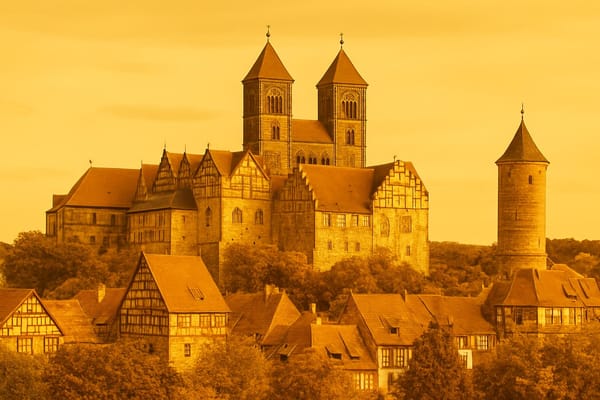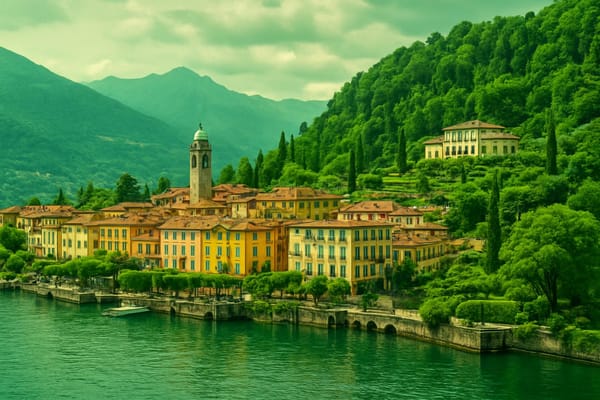Rothenburg ob der Tauber
Explore medieval charm: cobblestone lanes, timbered houses, ancient walls & Christmas market.

Important things to know about Rothenburg ob der Tauber
Rothenburg ob der Tauber in Germany is a striking example of a small medieval Bavarian town whose identity is shaped by its historic architecture, narrow cobblestone lanes and a sense of preserved time that often feels cinematic; the compact urban fabric is dominated by timber-framed houses, steeply pitched roofs and small courtyards that create intimate public spaces where locals and visitors sense the continuity of everyday life across centuries. Nestled in the heart of Bavaria and set above the Tauber River valley, Rothenburg’s streets are lined with family-run bakeries, traditional cafes and artisan shops that reflect regional craftsmanship and Franconian culinary traditions, contributing to a living cultural atmosphere rather than a museum-like stillness. The town’s mood shifts gently with the seasons: misty autumn mornings accentuate the textured facades, winter light softens stone and wood, and summer evenings bring a warm glow to the alleys, all of which influences the rhythms of markets, culinary habits and local festivals rooted in community life. Urban scale here favors walking and small-scale commerce, fostering strong neighborhood ties and a pedestrian-oriented lifestyle; public spaces feel human in proportion, and the interplay of narrow passages, small squares and green belts above the river gives Rothenburg a layered spatial character. For anyone researching or writing about small-town Germany, Rothenburg ob der Tauber stands out as a case study in historical preservation, regional identity and the way built heritage shapes contemporary social and economic patterns in a picturesque yet functioning European town.
Sightseeing hot-spots in Rothenburg ob der Tauber
Rothenburg ob der Tauber is a medieval town jewel in Germany that ranks high on many travelers’ lists for sightseeing along the Romantic Road. Narrow cobblestone streets, half-timbered houses and the iconic narrow perspective of the Plönlein create postcard-perfect scenes at every turn. Visitors exploring the town quickly notice how well preserved the architecture is: the skyline punctuated by ancient towers and the long, walkable City Walls offer a deep sense of history that makes Rothenburg ob der Tauber feel like a living museum rather than a reconstructed attraction.
At the heart of town the Town Hall and the Market Square draw crowds for both their architecture and for events, while St. Jacob's Church houses remarkable art and a medieval atmosphere worth experiencing. Museum options range from the chilling and fascinating Medieval Crime Museum to the festive wonder of Käthe Wohlfahrt’s year-round Christmas Market displays; both are prime stops for anyone interested in local culture and the unusual. Don't miss a guided Night Watchman Tour for theatrical storytelling and hidden corners, and be sure to taste local specialties like the Schneeball, a Rothenburg pastry that adds flavor to any sightseeing itinerary.
For the best panoramic photos and quieter moments, walk the City Walls at dawn or sunset to overlook the Tauber valley, where pastoral landscapes frame the town and reward visitors seeking Instagram-ready views. Planning practical sightseeing in Rothenburg ob der Tauber is easy because most highlights cluster in the compact center, making it ideal for a day trip or a leisurely overnight stay while you travel Germany. Whether you’re drawn by history, festivals, or simply the picture-perfect streets, Rothenburg offers a timeless experience that keeps visitors returning year after year.
Hotels to enjoy in Rothenburg ob der Tauber
Rothenburg ob der Tauber is a magnet for travelers seeking authentic medieval charm, and the selection of hotels in Rothenburg ob der Tauber matches that historic atmosphere with a range of options from cozy family-run guesthouses to elegant boutique hotels and refined luxury properties. Many accommodations sit within the Old Town walls or offer panoramic views of red-tiled roofs and cobblestone lanes, making it easy to step from your room onto the Romantic Road experience. Guests can expect complimentary gourmet breakfasts, modern comforts like free Wi‑Fi and parking, and special touches such as exposed timber beams, period furnishings, or spa facilities that blend contemporary convenience with period charm. Whether you’re looking for a budget-friendly room for a weekend getaway or an upscale suite for a romantic escape, Rothenburg’s diverse hotel scene provides memorable stays that emphasize local hospitality and historic ambiance.
When choosing accommodation in Rothenburg, location is key: selecting a hotel near the market square or close to the city walls lets you maximize sightseeing time and night walks through illuminated streets. Seasonal events, including the famous Christmas Market, make advance booking essential, while midweek stays often yield better rates and availability. For SEO-minded travelers researching Rothenburg ob der Tauber hotels, consider properties that highlight proximity to landmarks like St. James’s Church, the town museum, and the scenic viewpoints along the ramparts. With thoughtful choice of lodging-whether charming, budget-conscious, or full-service-you’ll enjoy easy access to local restaurants, guided tours, and the timeless atmosphere that defines this quintessential Bavarian destination.
Restaurants to try in Rothenburg ob der Tauber
Rothenburg ob der Tauber offers a dining scene that perfectly matches its storybook streets, where Rothenburg ob der Tauber restaurants range from cozy taverns to elegant venues tucked behind timbered facades. Visitors searching for the best restaurants Rothenburg will find a delightful mix of traditional German cuisine and inventive seasonal plates, often showcasing Franconian specialties like roasted pork, hearty sausages and delicate schnitzel. Many eateries embrace local produce and seasonal ingredients, pairing rustic dishes with local wines from the Franconia region or a refreshing German beer. Dining in the historic Old Town adds an atmospheric charm - candlelit rooms, wooden beams and courtyard terraces create memorable meals that feel like part of the town’s centuries-old heritage.
Choosing a place among the charming streets is part of the experience: whether you want a relaxed lunch by a bakery, a romantic dinner overlooking the market square, or a tasting menu at one of the top-rated spots, restaurants in Rothenburg ob der Tauber cater to varied tastes and budgets. Don’t miss regional treats such as Schneeballen, and be sure to explore family-run taverns for authentic flavors and warm hospitality. For food travelers aiming to find the best restaurants Rothenburg offers, booking ahead during peak tourist seasons and asking locals for recommendations will lead to the most satisfying culinary discoveries amid the town’s cobblestone streets and picturesque squares.
Best shopping stops in Rothenburg ob der Tauber
Rothenburg ob der Tauber is a shopper’s dream for anyone seeking medieval charm combined with authentic regional goods. Wandering the cobbled lanes of the Old Town, visitors discover an array of tiny boutiques and family-run stores that specialize in traditional crafts, hand-painted porcelain, leather goods and delicate jewelry. A highlight for many is the famous Käthe Wohlfahrt Christmas shop, where handmade Christmas ornaments and intricately carved nutcrackers line the shelves year round, creating a festive oasis even in summer. Food lovers will enjoy sampling local specialties like the buttery Schneeballen, while artisan workshops offer demonstrations of glassblowing and woodcarving, giving shoppers the chance to buy unique souvenirs made on-site. The rich visual landscape of half-timbered houses and medieval towers enhances every shopping stroll, making each purchase feel like a piece of Rothenburg history.
Beyond the main thoroughfares, the less-trodden alleys reveal hidden gems: antique stores brimming with stories, contemporary boutiques with modern German design, and small galleries showcasing local artists. Seasonal events, especially the renowned Christmas Market, amplify the town’s appeal, turning Rothenburg ob der Tauber into a year-round destination for gift hunting and collectors alike. Friendly shopkeepers who know the region’s traditions often personalize purchases with wrapping or provenance stories, adding value for those searching for meaningful keepsakes. For travelers planning shopping in Rothenburg ob der Tauber and the wider Tauber Valley, the town’s compact layout makes it ideal for leisurely exploration, ensuring every turn yields another delightful find that reflects the best of German craftsmanship and timeless style.
Nightlife highlights in Rothenburg ob der Tauber
Rothenburg ob der Tauber nightlife enchants visitors with a medieval atmosphere that comes alive after dark. As lanterns and twinkling lights illuminate the cobblestone streets and the fabled Plönlein, evening strolls along the illuminated walls reveal panoramic views that are uniquely romantic. The famous Night Watchman tour offers a theatrical glimpse into the town’s history and is a must for anyone exploring Rothenburg’s old town after sunset. Photographers and couples alike favor the quiet alleys and plazas where historic architecture is bathed in warm light, making it easy to soak up the castle-like ambiance and capture unforgettable night shots.
When the evening calls for food and drink, Rothenburg’s compact center delivers cozy pubs, rustic wine taverns and intimate bars serving local specialties. Savor hearty Franconian fare paired with Franconian wine or a frothy regional beer in centuries-old cellars and courtyard restaurants that preserve the town’s convivial spirit. Live music occasionally spills into the streets from small venues, and during winter the festive Christmas market transforms the nightlife into a glowing seasonal celebration. Whether you prefer a peaceful nightcap beneath the ramparts or a lively table full of local flavors, Rothenburg ob der Tauber nightlife balances tradition and warmth for an unforgettable evening.
Getting around in Rothenburg ob der Tauber
Rothenburg ob der Tauber is well served for travelers despite its medieval appearance: the closest major airports are Nuremberg Airport (about an hour to 90 minutes by car or rail depending on connections) and Frankfurt Airport (roughly two hours by car or faster by high‑speed rail from nearby hubs), with Stuttgart and Munich airports also reachable for international flights; once you arrive at a major airport, you typically continue by Deutsche Bahn regional and intercity trains to Würzburg, Ansbach or Steinach, where straightforward transfers link to the local branch line serving Rothenburg ob der Tauber; the town’s train station sits outside the medieval walls and is connected to the old town by regular shuttle buses, taxis or a 20–30 minute walk, and regional train frequencies are generally comfortable for day‑trippers and overnight visitors, with more options in tourist season-making Rothenburg easy to reach by combining airport-to-train travel, efficient rail connections, and short local transfers that keep this historic destination accessible for international and domestic travelers alike.
Culture must-see's in Rothenburg ob der Tauber
Rothenburg ob der Tauber captivates visitors with its medieval atmosphere and impeccably preserved cityscape, making it one of the most photographed destinations in Bavaria and Franconia. Walking along the fortified walls and cobbled lanes, travelers encounter iconic sights like the charming Plönlein, the soaring spire of St. Jakob’s Church with its famous Riemenschneider altar, and the informative Medieval Crime Museum that sheds light on law, punishment, and daily life in historic Germany. The town’s cultural heartbeat is amplified by guided Night Watchman tours, traditional folk music, and small galleries where contemporary artisans reinterpret centuries-old crafts. These layered experiences help explain why Rothenburg ob der Tauber remains a must-see in the Tauber Valley, blending architectural heritage with living traditions that attract historians, photographers, and families alike.
Beyond the monuments, Rothenburg’s calendar is rich with festivals and culinary traditions that reinforce its cultural identity; the winter Reiterlesmarkt or Christmas Market transforms the market square into a fairy-tale scene, while year-round craft workshops in the Handwerkerhof celebrate local skills. Food culture is also a highlight: sampling a sugary Schneeballen and pairing it with Franconian wine or local beer connects visitors to regional tastes. Small museums, seasonal art shows, and heritage performances keep the town dynamic, and community-led conservation projects ensure the medieval fabric remains intact for future generations. For anyone researching cultural travel in Germany, Rothenburg ob der Tauber offers a concentrated, authentic experience where history, cuisine, and festival life converge in a picturesque setting.
History of Rothenburg ob der Tauber
Rothenburg ob der Tauber in Bavaria, Germany, stands as one of the most evocative living museums of medieval European history, its cobbled streets and intact city walls transporting visitors back centuries. The town's origins reach into the early Middle Ages and it emerged as an important fortified market center on trade routes that linked Franconia to the Rhine. By the late 13th century Rothenburg had secured status as a Free Imperial City, which gave it political autonomy and economic advantages that fueled the construction of its landmark walls, gates, and towers. Prosperity in the medieval period is visible in its Gothic and Renaissance architecture, the imposing Town Hall, and the church of St. James with its famous altarpiece. Historical episodes such as the dramatic siege during the Thirty Years' War and the local legend of the Meistertrunk, where the mayor supposedly saved the town by downing a colossal quantity of wine, are woven into the cultural memory and heritage tours that draw scholars and tourists alike. Because Rothenburg’s fortunes waned after the 17th century, many original buildings were preserved rather than replaced, creating today’s uniquely authentic medieval atmosphere that has made the town a cornerstone of the Romantic Road itinerary and a focal point for heritage tourism in Germany.
The 19th and 20th centuries brought renewed attention to Rothenburg ob der Tauber as travelers, artists, and preservationists celebrated its picturesque streets, leading to conservation efforts and the development of cultural attractions such as the year-round Christmas Market and traditional craft shops like Käthe Wohlfahrt. Political shifts in the Napoleonic era saw Rothenburg mediatized and integrated into the Kingdom of Bavaria, and although the town suffered bombing damage in World War II, extensive postwar restoration-supported in part by international donations-carefully rebuilt damaged sections to match the historical fabric. Today Rothenburg balances its role as a living community with that of a major historical destination: museums, guided walks, and festivals interpret centuries of urban life while the fortified ramparts provide panoramic views of the Tauber Valley. For anyone researching medieval Germany, Bavarian culture, or historic urban preservation, Rothenburg ob der Tauber offers a concentrated, well-preserved case study of medieval planning, civic autonomy, and the modern challenges of tourism and conservation.



